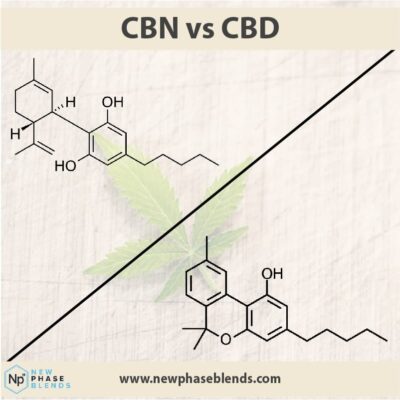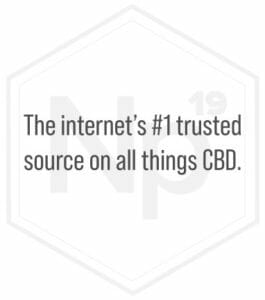Hundreds of cannabis plant compounds have been discovered, and only a few have received the spotlight they deserve. Cannabinol, or CBN, is one of these compounds known as a cannabinoid. Researchers have compared several cannabinoids and found some potential therapeutic benefits of them, including CBN. Most people know of the cannabis plant compound cannabidiol, or simply CBD. Comparing the differences of CBN vs CBD is one way that we can see exactly what CBN does, and how it compares with CBD. Both CBN and CBD might look similar from a molecular standpoint, but these are two very different cannabis plant chemicals.
TL;DR – Cannabinol (CBN) and Cannabidiol (CBD) are both cannabinoids found in cannabis plants. Their molecular structure is different, and their potential health benefits differ a bit, too. CBD also has much more scientific research to back it, while CBN has very little. For this reason, many claims about CBN remain, largely, anecdotal.
What are the Differences Between CBN vs CBD?
CBN, back in 1896, was the first cannabinoid that was isolated in its purist form. People actually thought that it was responsible for the psychoactive effects of cannabis. We now know that different forms of THC are, in fact, responsible for these psychoactive effects. Originally CBN was the culprit! Interesting, isn’t it?
This is one of the reasons that CBN is still heavily regulated in some areas. It wasn’t until later that the researchers showed CBN doesn’t produce intoxicating effects on its’ own.
The effects of CBN have not been thoroughly studied in human subjects – yet. Keep this in mind when you see products with CBN that make loads of medical claims.
Sure, they could be true, but there aren’t enough scientific trials to substantiate the claims.
The obvious differences between these two cannabinoids that many people first notice are a difference in their chemical structure. Aside from that here are some other differences that we will get into:
- different (potential) health benefits
- different concentrations of both cannabinoids in plants
- research is far more common on CBD than CBN
- both act interact differently with other cannabinoids
- interactions with the endocannabinoid system may vary, slightly
Different Health Benefits of CBN vs CBD
Cannabinol, or CBN, is a compound of the cannabis plant (marijuana and hemp are both cannabis plants) famous for its non-intoxicating properties and a remarkable similarity with CBD. It is one of over 100 different cannabinoids (plant chemicals) that we have discovered within cannabis.
Cannabidiol, or CBD, is also a cannabinoid that is non-intoxicating, but has far more documented studies as far as medical uses are concerned. CBD first become popular for its’ use to help treat certain types of seizures, and has sense taken the world by storm.
The health benefits of CBD are well studied, and well-documented. These include:
- pain relief
- anxiety relief
- anti-inflammatory effects
- reduction of certain types of seizures
There are more reported benefits, but these are the most common.
The data is lacking, but CBN is thought to help largely with sleep. To be honest, there are no human studies on CBN for sleep improvement, so most of this is based off of theory and animal studies. For now, stick with CBD for sleep improvement. We’ll get more into CBN and sleep later on in this article.
Related: CBD vs CBDa
How Are CBD and CBN Made?
Cannabinoids, like CBD, are made in a couple different ways. One of these ways is called oxidation. Let’s explore oxidation a little bit, and how it affects cannabis compounds. Several different cannabinoids in the cannabis plant can oxidize into different compounds, depending on their makeup.
Oxidation can happen in a few different ways. We’ll discuss the two most popular forms which are:
Light exposure: Light, particularly ultraviolet (UV) light, can accelerate oxidation reactions. This is because light energy can break the bonds in a molecule, producing free radicals – atoms, molecules, or ions with unpaired valence electrons. These free radicals are highly reactive and can induce oxidation reactions. This process is a significant factor in photo-oxidation reactions, which occur when materials (such as plastics or organic matter) are exposed to light. Photo-oxidation can lead to degradation of materials, causing fading, brittleness, and other undesirable changes.
Time: Time is a direct factor in oxidation because the longer an object is exposed to an oxidizing agent (such as oxygen), the more oxidation will occur. Oxidation is a process that happens over time, and it generally continues until the reactants are completely consumed or something intervenes to halt the process. Depending on the conditions and materials involved, this can happen over minutes, hours, days, or even longer periods.
In many real-world applications, efforts are made to slow or prevent oxidation. This can involve minimizing exposure to light (especially UV light), reducing the time of exposure to oxygen, and using antioxidants. Antioxidants are substances that can inhibit or slow down oxidation reactions, often by neutralizing free radicals.
CBN Comes From THC
Manufacturers can expose THC rich plants to extreme UV lighting in order to force the oxidation process. Over time, the excess exposure to UV lighting slowly turns the THC into CBN. Most effects of THC are lost in this process.
Instead of keeping the hemp plants, or biomass, in a dark, cool area, these producers will deliberately exposure it to a lot of heat, and a lot of light, to force the process to go even quicker. Cannabis compounds respond to light and heat in a similar manner.
The end result is a CBN rich product. Check out this picture of a UV light being used to exposure impurities in minerals. You’ll notice it uses a blue-ish spectrum of light, similar to a black light.
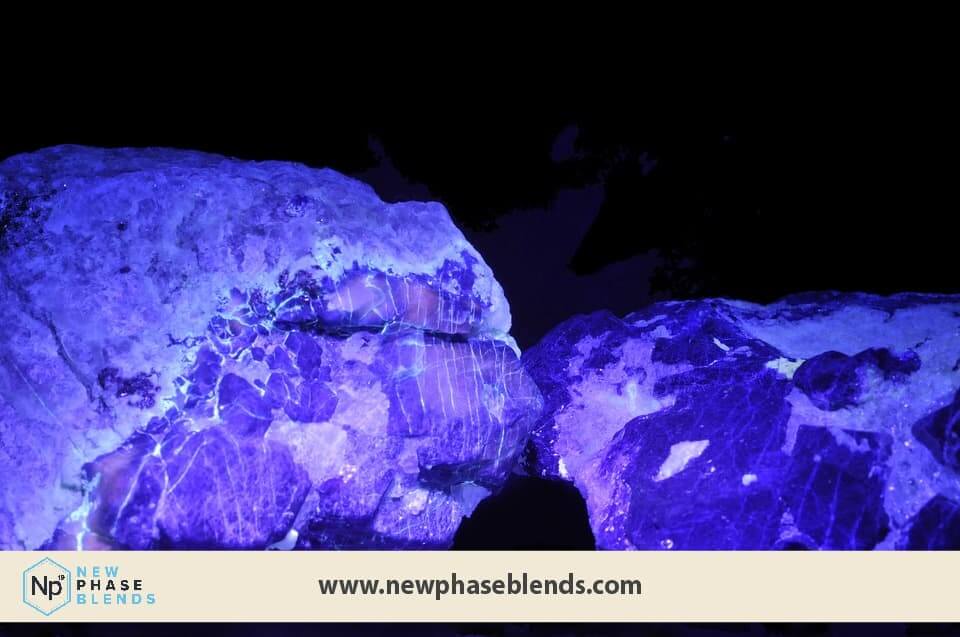
We’ve found that CBN is a byproduct of degrading tetrahydrocannabinol, or THC. This simply means when THC ages and decays into an old compound, it turns into cannabinol. If you have ever stored your marijuana incorrectly, this would be the result.
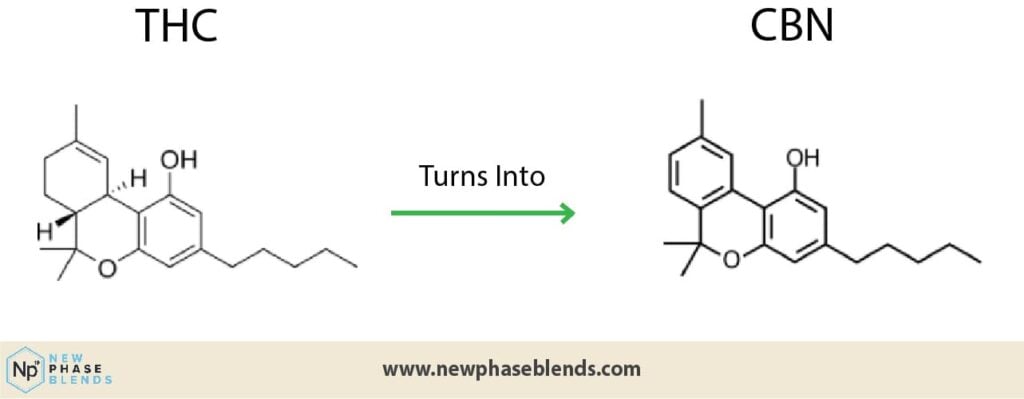
That means CBN may exist in large amounts the older the plant is. Since we can’t (unfortunately) alter time, people will typically use the UV light method to force the oxidation process – if that’s what you want to do.
Currently, levels of CBN in cannabis depend on environmental factors instead of genetic factors of the particular strains. For this reason, there are currently no super-high CBN strains on the marketplace yet. This is one area that’s rather interesting, since there are several high CBD strains that exist. Growers are always looking for ways to improve their strains when they breed cannabis plants.
Related: Comparing THC and CBD
CBD Comes From CBGa
As a cannabis plant grows, it contains a high amount of the cannabinoid known as CBG (cannabigerol) and CBGa (cannabigerolic acid).
CBGa transforms into THCa (tetrahydrocannabinolic acid) and CBDa (cannabidiolic acid). CBDa then turns into CBD after a process known as decarboxylation occurs. We won’t get too deep into this process, but essentially CBDa is exposed to heat, which then causes a transformation from the acid form of CBD (CBDa) into the popular cannabinoid known as CBD.
CBN, CBD, and Your Endocannabinoid System
The Human Endocannabinoid System (also known as ECS) is a complex network of receptors, endocannabinoids, and enzymes that are located all throughout our bodies. The ECS aids in doing several different things that gives us medical benefits, but maintaining a bodily homeostasis is, perhaps, it’s most important role.
Additionally, the sedative properties (in addition to other wellness benefits) of CBN are all thanks to this system.
This system processes cannabinoids, like CBD and CBN. Our bodies produce endocannabinoids all on its’ own.
Essentially, there are two major endocannabinoids that we have been able to locate so far.
- Anandamide (AEA or arachidonoyl ethanolamine)
- 2-archidonoyl glycerol (2-AG)
Many different researchers are confident that there are even more of these endocannabinoids. As more research continues and more scientific evidence is discovered, we will be able to locate even more of them.
Understanding how the Endocannabinoid System works is very important, because cannabinoids like CBN and CBD may stimulate different receptors within this bodily system.
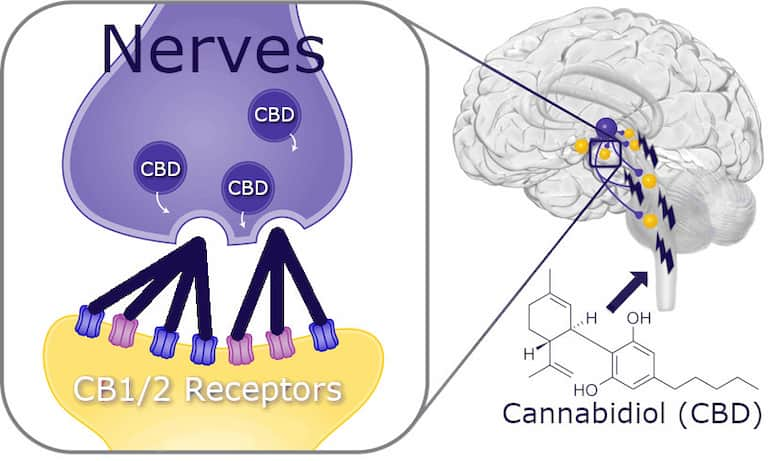
The result from the receptors being stimulated is what we feel after taking things like CBD. These results can come in the form of:
- chronic pain relief
- anti-inflammatory effects
- relaxation
- enhanced focus, memory, and cognition
- blood pressure regulation
These are only three of the more popular results from using cannabinoids.
Cannabinoid Receptors
The two major receptors we know about within the ECS are called the CB1 and CB2 cannabinoid receptors. These receptors are located in different areas throughout our bodies. Both CBD and CBN can influence these receptors, as we spoke about previously.
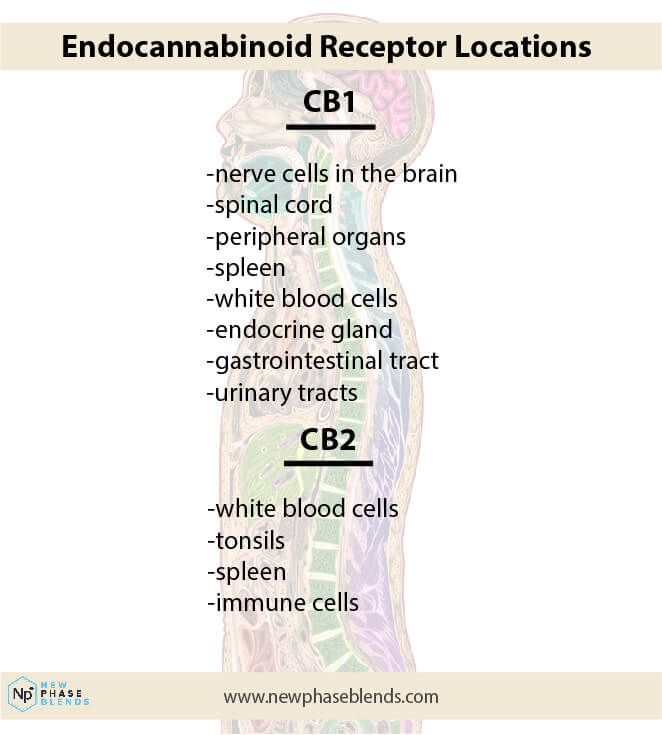
It might look like there are CB receptors located everywhere, but a vast majority are located within the brain. The other areas do contain them, but in much smaller amounts.
Both of these CB receptors can be stimulated by using products with cannabinoids in them, similar to CBD balms, gummies, or even vaping.
The Effects CBN and CBD Have on the Body
In this next section, we’ll break down the different effects that CBN and/or CBD have on our body. Remember, CBN lacks a lot of scientific studies, so most of the benefits will be derivatives from THC (the parent cannabinoid to CBN).
Relaxation
Cannabinol has shown an ability to induce relaxing effects on the human brain and body. A study published in 2011 in the British Journal of Pharmacology made a claim that the combination of THC and certain levels of CBN could produce a “tranquilizing” effects in humans.
This is, most likely, due to the fact that THC is also very good at relaxing people. Since CBN is literally THC that has been degraded over time, the plant chemical community believes it likely holds on to several of the same effects that THC had.

These two compounds are responsible for a large portion of the sedative effects people feel after using cannabis or marijuana products. Aged cannabis products, or those with more exposure to heat and sunlight, showed better results in relaxing the human body.
This is primarily because of the amount of THC that has converted to CBN, like we spoke about earlier. The older cannabis products contain higher CBN content which makes them more useful for relieving purposes – or so it seems.
Anti-inflammatory and Anti-convulsant Properties
Researchers found out that a particular combination of CBN from cannabis extracts can offer decent pain relief because of its’ potential anti-inflammatory effects. Scientists need to manufacture a CBN isolate to conduct proper research, as a specific breed of a heavily CBN enriched cannabis plant does not yet exist.
This practice is one of the main hurdles for initiating further CBN-based investigations. In only two years, though, we have seen massive breakthroughs in developing CBD-rich strains. Maybe people will be able to find a way to cultivate a CBN-rich strain in the near future. Another idea is making a strain that is susceptible to converting THC to CBN more easily.
With all that’s been done in the last five years in regards to CBD research, I am confident someone will figure out a way past this hurdle soon.
Is CBN or CBD Better for Sleep?
The research in this particular area is lacking, but current results have shown CBN’s potential impacts on treating sleep disorders. The researchers have claimed CBN, based on limited research, is an effective sleep improving cannabinoid. The research really is quite poor, and most people will not acknowledge the accuracy of this study.
A recent study from 2021 actually concludes, “Individuals seeking cannabis-derived sleep aids should be skeptical of manufacturers’ claims of sleep-promoting effects.”
For now, we highly recommend you stick to using CBD oil for sleep instead of a cannabinol product.
Appetite Stimulant
Researchers discovered (through an animal study) that CBN stimulated the appetite in rats. You can read the study yourself by clicking the link, but there isn’t much data to back the claim. In the future, I can only hope that more cannabis research is conducted in this area.
We know that THC can be an appetite stimulant, so hopefully the research scientists aren’t mixing this one up as well.
Using CBN as an Anti-Biotic
Imagine being able to clear out harmful bacteria from your body. Well, CBN might actually be able to do this, and do it well.
Cannabis research was conducted in 2008 which tested CBN and several other cannabinoids (including CBD) from the cannabis sativa plant. The results showed that CBN was effective in helping treat MRSA, a type of bacterial infection that can be heavily resistant to a lot of different anti biotics.
Methicillin-resistant Staphylococcus aureus (MRSA) infection can be caused by a special kind of staph bacteria. It is resistant to a lot of different anti-bacterial products that people normally would use to clear out a staph infection. More research in this area would be fantastic to see.
Explore Better Bone Healing and Growth With CBN
Some pretty cool new research shows us that cannabinoids, including CBN, can actually aid in stimulating the growth of new bone cells. This is done by activating stem cells which aid in the process of creating the new, healthy bone cells.
There’s also some promising news that shows CBN, and many other cannabinoids, just might be beneficial in helping regenerate fractured bone, and even helping reduce bone loss.
This makes CBN extremely interesting to many different scientists because it can help in the fight against osteoporosis.
Do CBD and CBN Make You Feel High?
Neither CBD nor CBN exhibit psychoactive effects that lead to intoxication. As mentioned earlier, in the original stages of research on cannabis, we actually presumed CBN was responsible for getting people high. We later learned that this is not true. When THC degrades into CBN, it loses the ability to get people high. Some organizations may consider CBN a ‘mild psychoactive’ in that it has the ability to make you feel tired, which we debunked earlier in this article.
Is CBD Better than CBN?
This is a tough question to answer since we know a lot about CBD, and a tiny amount about CBN. Since we have so much documented studies on CBD, I am going to side with CBD over CBN. If more studies are conducted on CBN that provide conclusive, beneficial data, then maybe I’ll end up changing my stance. We simply don’t know enough about cannabinol.
CBN Products vs CBD Products
Some CBN products are available on the market. That being said, CBN products are not really all that common. Your best bet is buying a true, full spectrum CBD product. These full spectrum items are likely rich in CBN, as long as they are real. You’ll be able to get your dose of CBN in these products.
In the section above, we spoke about the need for THC to degrade into CBN. This is a very long process, and we haven’t figured out a way to speed things up, or create high CBN strains in the hemp plant.
For this reason, there is just not going to be a lot of CBN isolate, or super high CBN content products for sale. For those of you who are able to find them, well, you’ll probably notice the high price tag, too.
Besides, using a very high concentration of CBN isn’t really proven to be needed at this point. As long as your CBD products contain a healthy ratio of all major cannabinoids, you will be good to go.
Summary – CBD and CBN: What is the Difference?
Both CBD and CBN share multiple similarities, but are completely different cannabinoids. Just as CBD and THC are different from each other, so are CBN and CBD.
Research has shown that both have the potential for numerous health benefits. Here is a quick recap on everything we went over:
- CBN is the result of THC that has degraded. It can degrade over time, or by light exposure.
- Both are very similar on a molecular level.
- They seem to offer similar benefits.
- CBN is non psychoactive and non intoxicating, just like CBD.
Remember, our bodies are armed with a fully functioning Endocannabinoid System that works wonders when it comes to processing different cannabinoids. Our bodies produce endocannabinoids, but we can also supplement with external sources like CBD, CBN, or other products.
We simply need to do a lot more research to fully understand how CBN affects the body. There are ways it can be used as a safe, effective therapy for several different conditions.
We are hoping that more medical claims will be further substantiated with a legitimate, comprehensive study. Since CBD and CBN became legal, the number of studies on cannabinoids have sky rocketed, and it’s only a matter of time before we will know more.



